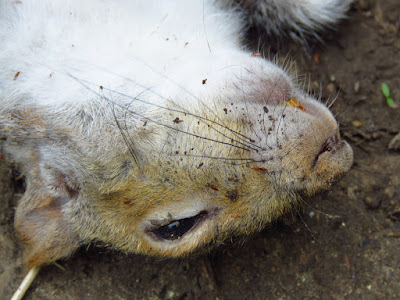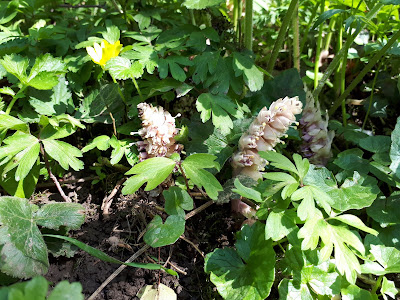The first stop is Kirkdale cave, discovered in 1821, and which obtained fame due to its assemblage of megafauna fossils from the last interglacial, the Ipswichian (about 110,000 years ago). The fossils included the northernmost hippo fossils, elephant and hyena. They were studied and described by William Buckland, who interpreted the assemblage as the remains of cave hyena prey in the hyena's den. Today the cave sits on a small quarry and its small entrance is about 5 m above the ground.
The quarry with Kirkdale cave.
Andrew Chadwick bravely climbs to Kirkdale cave entrance.
We continue upstream in the wooded vale, with plenty of wild garlic and wood anemones.
Wood anemone.
The beck runs dry by the path. We have a lot of Bee Flies, including a mating pair. We stop for lunch by another ford by the dry beck. In this area there are no pools, but there seem to have been running water recently.We carry on through the woods. At some point we notice the beck is flowing happily by us and it carries so until we get to Hold Cauldron mill, where the weir also flows in abundance.
Two lucky members of the groups get to watch a dipper leaving a likely nest site by mill. We return to the car via the other side of the beck.
Our butterfly list included Peacock, Orange Tip, small tortoiseshell and an unidentified white, none of them settled for photos though.
We cover three km2 and just over 5 km, entertained by the diverse wildlife in the woods and beck. A most enjoyable day out. If you are interested in the plant, invertebrate or bird lists for the day, check the Hull Nats website.
Marsh Tit
Early-purple orchid, Orchis mascula,
Some Caddis flies on a stagnant pool by the ford.
Mayflies.
A field behind the church.
The remains of a bridge near the ford.
Small Frog.
A beautiful flowering willow buzzing with bees.
Morel mushroom.
A recently deceased grey squirrel squirming with fleas.
Spurge-laurel, Daphne laureola.
Early dog violet (top left) growing near Common dog violet (bottom right).
Basking Bee fly, Bombylius major.
A very dirty Oiceoptoma thoracica carrion beetle trying to fly.
Hold Cauldron Mill and weir from the bridge.
A large patch of white lichen on the bridge.
Stone fly Perlodes mortoni, with thanks to Sharon Flint for her ID.
A section of Hodges Beck in flow.
Motley crew of invertebrates under a log, including Pill Millipedes, Nemastoma bimaculatum harvestman and the millipede Tachypodoiulus niger.
Pill millipede and small stonefly under log.
Hoverfly Eristalis pertinax.
Primroses.
Common dog violets.
Toothwort.
Carpet of wood anemones
Moschatel, Adoxa moschatellina
Part of the group walking by the dry riverbed.
The beck flowing.
Before leaving we walk around Gregory's minster.
A very megalithic looking stone by the church.
Ancient tombstone reused to rebuild the church
A pair of crosses used to rebuild the church.







































No comments:
Post a Comment